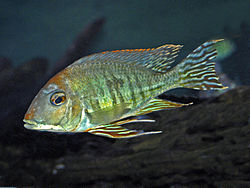| Geophagus | |
|---|---|
 | |
| Geophagus altifrons | |
| Scientific classification | |
| Kingdom: | Animalia |
| Phylum: | Chordata |
| Class: | Actinopterygii |
| Order: | Cichliformes |
| Family: | Cichlidae |
| Subfamily: | Cichlinae |
| Tribe: | Geophagini |
| Subtribe: | Geophagina |
| Genus: | Geophagus Heckel, 1840 |
| Type species | |
| Geophagus altifrons Heckel, 1840 | |
Geophagus is a genus of cichlids that mainly live in South America as far south as Argentina and Uruguay, but a single species, G. crassilabris is from Panama. [1] [2] They are found in a wide range of freshwater habitats. [3] They are part of a group popularly known as eartheaters and mostly feed by picking up mouthfuls of sediment to sift out food items such as invertebrates, plant material and detritus. [3] The largest species reach up to 28 cm (11 in) in standard length. [3] They are mostly kept in aquariums. [4]



